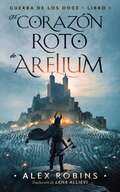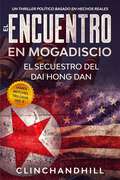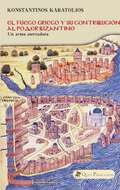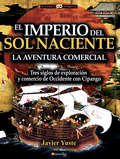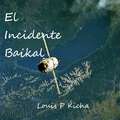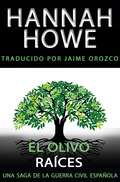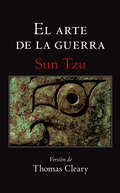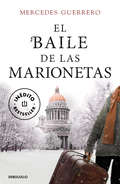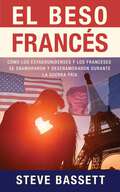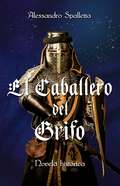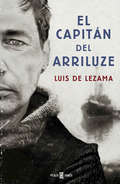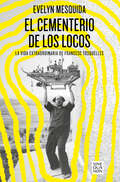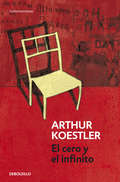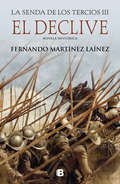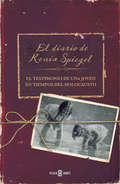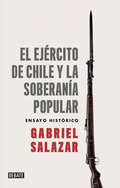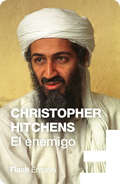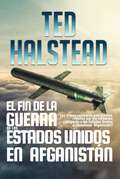- Table View
- List View
El Corazón Roto de Arelium (Guerra de los Doce #1)
by Alex RobinsAlgunas cosas nunca deben olvidarse. Hace más de 400 años, doce grandes guerreros unieron los asediados ejércitos de hombres y recorrieron las tierras devastadas por la guerra, empujando al enemigo hacia los pozos y cavernas subterráneas de donde venían. Con el propósito de asegurar su legado, cada uno de los Doce fundó monasterios-fortalezas para impartir su conocimiento único de la guerra y la política a unos pocos, los Caballeros de los Doce. Ahora, el último de los Doce ha pasado de la historia a la leyenda y las menguadas órdenes de los Caballeros albergan un oscuro y terrible secreto que debe ser protegido a toda costa. Merad Reed, anhela escapar de la sombría y monótona realidad que lo ha tenido cautivo la mitad de su vida protegiendo un gran cráter conocido como El Foso. La llegada de Aldarin, uno de los pocos Caballeros de los Doce que quedan, precipitará una cadena de eventos cataclísmicos que transformaran a Reed para siempre. Al norte, Jelaïa del Arelium, heredera de la más rica de las nueve baronías, debe aprender a navegar por las turbulentas corrientes políticas de la corte de su padre, si espera algún día ocupar su lugar. Pero las llamas parpadeantes de la ambición esconden la sombra de una amenaza aún mayor. Y en lo profundo de la tierra, algo se mueve.
El Encuentro en Mogadiscio: El Secuestro del Dai Hong Dan (James Mitchel trilogía No. 3 #3)
by ClinchandhillA medida que aumentan las sospechas de un cargamento muy peligroso a bordo del Dan, Mitchel y sus colegas nos llevan a un emocionante viaje en el que el peligro y la amenaza de una guerra nuclear son inminentes. El Encuentro de Mogadiscio es la última aventura de la trilogía de James Mitchel, inspirada en hechos reales. Clinchandhill vuelve a unir realidad y ficción, drama y diálogos que mantendrán al lector atado al libro de principio a fin.
El Fuego Griego y su contribución al poder bizantino
by E2e Konstantinos KaratoliosUna maravilla como el Imperio Bizantino de los mil años no podría haber sido lograda sin sus fuerzas armadas, que le permitieron mantener su poder frente a los constantes retos que le presentaban enemigos externos de naturalezas significativamente diferentes. En un contexto así, lo heredado de los romanos era tan importante como la adopción de nuevas armas y tácticas de batalla. El Fuego Griego, pese a no ser la más importante arma, era ciertamente la que más fama cosechó. Fue utilizada en todo el imperio ayudando a conseguir espectaculares victorias a su marina. Este arma aterradora marcó época, y pese a ello todo lo que sabemos sobre su historia se encuentra difuminado por la vaguedad de los escritos contemporáneos. En este trabajo, Konstantinos Karatolios trata de responder una serie de preguntas relacionadas con el Fuego Griego: ¿Cuál era la fórmula? ¿Qué efectividad poseía? ¿Quién es su verdadero creador? ¿Cómo se utilizaba en batallas de tierra y mar? Este libro trata de no solo ofrecer una visión breve y global sobre el estado actual de las investigaciones que puede ser fácilmente leída por no especialistas, haciendo al mismo tiempo una contribución a su estudio respetando los métodos de investigación académicos.
El Imperio del Sol Naciente (Historia Incógnita)
by Javier Yuste GonzálezTres siglos de exploración y comercio de Cipango con Occidente. 1542-1868: 300 años de contactos culturales y comerciales de Cipango con occidente: Desde el shogunato y la reunificación de Japón por Nobunaga, Toyotomi y Tokugawa hasta la restauración del poder imperial. Historias, aventuras, exploraciones y conflictos bélicos. La apasionante historia de la modernización del fascinante Japón.Conozca la narración apasionante de las historias, aventuras y desventuras protagonizadas por aquellos hombres que, zarpando desde puertos andaluces y lisboetas, desde Ámsterdam, Londres y otros tantos lugares, quisieron llegar hasta la mítica Cipango que Marco Polo describió en el s. XIII; unas islas pobladas por los hombres del Oriente dotados de un nivel culturals superior y rodeados de riquezas tales que solo el sol podría haber creado. Una obra que recoge de forma exhaustiva más de tres siglos de contactos culturales y mercantiles, con sus sombras y sus luces, con abrazos fraternales y odios exacerbados. Una etapa clave de la humanidad, en plena conquista y descubrimiento de todas las tierras ocultas; de afán por saber qué se ocultaba en aquellos espacios en blanco que poblaban los mapas, en los que tan solo se leía la leyenda de Terra Incognita y sinuosos dragones se coronaban como únicos reyes y señores. Si se atreve a pasar de la primera página, se verá trasladado a 1542 a bordo de un junco chino junto a Fernán Mendes Pinto, así como, a bordo de un moderno navío de guerra americano en 1853. Y, entre tanto, presenciaremos el buen entendimiento entre japoneses y españoles, hasta que este salte en miles de pedazos bañados en sangre, que sirve de tinta para un mensaje de advertencia dirigido al rey Felipe IV. Más que historia es la aventura en pos de conocer nuestros vínculos originales con una tierra que, aún a día de hoy, sigue sorprendiéndonos.
El Incidente Baikal
by Louis KichaUn thriller de espías que abarca cuatro décadas. En 1970, un avión espía que transportaba una mortífera arma secreta se pierde sobre la Unión Soviética; se desconoce su ubicación. Cuarenta años después, se descubre en las profundidades del lago Baikal de Rusia. La carrera por recuperar la terrible arma antes de que caiga en manos del enemigo está en marcha.
El Olivo; Raíces: Una Saga de la Guerra Civil Española (El Olivo #1)
by Hannah HoweEnmarcado en el periodo de tiempo de abril de 1937 a Diciembre de 1938, El Olivo es una colección de mini-series de cinco novelas basadas en hechos reales. Las historias de El Olivo – Raíces, Ramas, Hojas, Fruto y Flores – narran la vida de Heini Hopkins, una enfermera joven de una empobrecida parte de Gales del Sur, y Naomi Parker, una autora rica de un privilegiado estrato social. En Raíces, Heini está en casa cuidando de su madre enferma en Gales, mientras Naomi asiste a presentaciones de su más reciente novela. La guerra civil en España parece un mundo aparte, hasta que los fascistas bombardean y destruyen Guernica, acabando con la vida de miles de hombres, mujeres y niños. El novio de Heini; Deiniol Price, es un hombre que trabaja en una mina de carbón que tiene la mirada puesta en ayudar a la causa de la Republica Española, buscando colaborar como voluntario en Brigadas Internacionales, mientras que el amante de Naomi; el conde Nicolas Esteban, es un piloto que sueña con la gloria de luchar junto los fascistas. ¿Qué destino les aguarda a Heini y Naomi si deciden seguir a sus hombres dejando la seguridad de Gales para adentrarse en los sangrientos campos de batalla en España?
El Paso Sunset: A Novel (The El Paso Novels)
by Louis BodnarThe Second American Civil War rages in the explosive saga that delivers “ruthless action, dark comedy, betrayal, love, and several strong friendships” (Lone Star Reviews).Following the unexpected cliff-hanger ending of the wildly successful and acclaimed four-state regional bestseller, El Paso Sunrise, the much anticipated El Paso Sunset continues the Steven Vandorol story . . .During the ultimate crisis of a Second American Civil War started by dark, sinister, and shadowy forces, only Steven and his friend, Vanessa Carson, stand in the way. But they face their worst nightmares of rape, kidnapping, and murder. El Paso Sunset is the second of two stand-alone novels that together make a story of love, passion, obsession, intense hate, pure evil, violence, and horror, all brought keenly alive against the panorama of the radical transformation of the great American Constitutional Republic.
El Vuelo de Violetta: Kahbia
by David Richard BeasleyUna joven birmana escapa de los japoneses en la Segunda Guerra Mundial. Los ejércitos japoneses invadieron una Birmania casi indefensa en 1942, enviando a decenas de miles de personas a huir por las montañas hacia la India. Ellos gobernaron a los birmanos restantes, ante quienes alardearon de liberarlos del dominio británico, con arrogancia y brutalidad. "El vuelo de Violeta" narra las experiencias de una joven anglo-birmana y sus parientes creciendo felices bajo los británicos y su terrible experiencia escapando de los japoneses, viviendo bajo la ocupación o luchando en la resistencia. Las batallas ganadas por los ejércitos aliados que salen de la India para retomar Birmania en 1944-45 son vistas a través de los ojos de los oficiales japoneses, que ven a sus ejércitos sufrir a su vez las agonías de la derrota en la guerra. Las semillas del fascismo sembradas por Aung San y su Ejército de la Independencia de Birmania uniéndose a la invasión japonesa, hasta desencantarse, crecieron como una hierba que envenenó a la sociedad birmana contra los anglo-birmanos y otras etnias, impidiendo su florecimiento con una dictadura de puño de hierro.
El amante japonés
by Rani ManickaCon la exuberante Malasia invadida por el ejército nipón como telón de fondo, la sensualidad de una mujer convertida en geisha en manos de un oficial japonés se transforma en una apasionante historia de amor prohibido en tiempos de guerra. Una mujer, un oficial enemigo y un amor que nadie podría sospechar. En Malasia, en los albores de la Segunda Guerra Mundial, tras un matrimonio concertado, Parvathi vive sin grandes alicientes en la opulenta mansión de su marido, un hombre mucho mayor que ella que prácticamente la desprecia. Solo gracias a la ayuda de una cocinera llena de sabiduría y a un criado que la ama en secreto, Parvathi logra seguir adelante. Pero la invasión japonesa del país cambia su vida ya que, tras el saqueo y la ocupación de su propio hogar, Parvathi se ve obligada a convertirse en la geisha y amante del oficial japonés al mando. Sin embargo, lo que empieza como el mayor de los sacrificios pronto se transforma en un amor prohibido que hará surgir en ella sensaciones que jamás había experimentado. Tal vez un amor que puede ir más allá de las fronteras de la guerra. La historia de amor prohibido entre una mujer convertida en geisha y un oficial japonés es el hilo argumental de la conmovedora novela con la que Rani Manicka confirma el merecidísimo éxito de su novela anterior, Madre del arroz. Reseñas:«Una novela fascinante y conmovedora en la que Rani Manicka, la autora del gran éxito Madre del arroz, recrea una épica historia de amor, pérdida y destinos universales.»Publishers Weekly «Una lectura maravillosa, realista y llena de color.»Choice «Una historia de amor alejada de cualquier convencionalismo y narrada con gran imaginación que nos traslada a un pasado exótico habitado por personajes asombrosos.»She
El anillo (Nueva Fontana Ser.)
by Danielle SteelUna historia de amor y lucha frente a las adversidades ambientada en la Alemania de la Segunda Guerra Mundial. En una Alemania inmersa en la guerra y el odio, la joven Ariana von Gotthard recibe el más preciado legado familiar: un anillo. Este se convertirá en símbolo del hogar perdido, pues tras ser separada de su familia, y sin posibilidad de escapar del país, Ariana es arrestada por los nazis. El amor, sin embargo, la salva de las más sombrías perspectivas y le brinda la oportunidad de huir al extranjero. Un viaje no exento de tragedias conduce a Ariana a Estados Unidos, hacia una vida incierta entre gente desconocida y temores nuevos. Ariana queda reducida a una mujer sin pasado y sin futuro, y el anillo al que todavía se aferra es el único recuerdo que guarda de su padre y su hermano. Lo que no sabe es que, con el paso del tiempo, el anillo le servirá como puente entre lo que dejó atrás y el provenir.
El arte de la guerra (Clásicos Ilustrados Ser. #Vol. 1)
by Sun Tzu Thomas ClearyRecopilado más de dos mil años atrás por un misterioso guerrero filósofo, El arte de la guerra sigue siendo, quizás, hoy en día, el libro de estrategia más prestigioso e influyente del mundo, estudiado en Asia por políticos modernos y ejecutivos con el mismo entusiasmo con el que fuera consultado en tiempos antiguos por jefes militares. Como estudio de la anatomía de las organizaciones en conflicto, El arte de la guerra se aplica en general a la competencia y al conflicto, en todo nivel, desde el interpersonal al internacional. Su objetivo es la invencibilidad, la victoria sin dar batalla, y la fuerza inexpugnable gracias a la comprensión de la física, la política y la psicología del conflicto. Compiled more than two thousand years ago by a mysterious warrior-philosopher, The Art of War is still perhaps the most prestigious and influential book of strategy in the world today, as eagerly studied in Asia by modern politicians and executives as it has been by military leaders since ancient times. As a study of the anatomy of organizations in conflict, The Art of War applies to competition and conflict in general, on every level from the interpersonal to the international. Its aim is invincibility, victory without battle, and unassailable strength through understanding of the physics, politics, and psychology of conflict.
El baile de las marionetas
by Mercedes GuerreroUna historia de amistad, de supervivencia, de personajes entrañables, de lealtades inquebrantables, amores imposibles y traiciones imperdonables. Afganistán, 2004. La doctora Edith Lombard, de Médicos Sin Fronteras, hace guardia en un hospital de Kabul. Al atender a una joven en quirófano advierte en su cuello algo que atrae su atención: un collar del que cuelga una perla de ámbar. Una perla que Edith reconoce enseguida, pues fue robada en su casa de Quebec dieciocho años antes, en un atraco en el que su madre falleció de un disparo. Una perla de la que su padre, Édouard Lombard, había contado que perteneció a la famosa Cámara de Ámbar de San Petersburgo, desparecida durante la II Guerra Mundial. Bilbao, 1937. Del puerto de Santurce está a punto de zarpar el Habana, que llevará a más de cuatro mil niños hasta la Unión Soviética, huyendo de la guerra civil que ahogaba el país. Allí, su historia, la historia de unos exiliados utilizados como marionetas por el gobierno de Stalin, se hilvanará con la de la perla de ámbar en un viaje de setenta años que desempolvará recuerdos que nadie quería que viesen la luz.
El beso francés: Cómo los estadounidenses y los franceses se enamoraron y desencantaron durante la Guerra Fría
by Steve BassettEn 1951, Francia estaba lejos de la recuperación de la Segunda Guerra Mundial y con la caída de los nazis, estaba a punto de comenzar una nueva ocupación militar totalmente diferente. Con los Estados Unidos como punta de lanza, la OTAN estaba avanzando. Al acecho, con todas sus armas, estaba el Partido Comunista Francés. El odio antiestadounidense que se escupía en periódicos y revistas, así como en las emisoras de radio controladas por el partido, resultó insuficiente para detener la construcción de trece bases aéreas estadounidenses que se establecieron en suelo francés, incluido el mayor depósito de suministros aéreos de Europa en Berry, la región más empobrecida del centro de Francia, la estación aérea de Déols-Châteauroux. Es aquí donde comienza nuestra insólita historia de amor franco-estadounidense. No sólo los comunistas, sino también otros grupos antiestadounidenses se unieron a los ataques contra el Tío Sam. El bombardeo publicitario incluía la condena del comportamiento de los soldados, grafitis de «Estadounidenses, váyanse», panfletos en las esquinas, peleas a puñetazos y, en un momento dado, el bloqueo e intento de cierre del CHAS. Los cientos de horas de entrevistas y las fotografías olvidadas hace mucho tiempo proporcionan por primera vez una fusión única de voces que rara vez se escuchan. Ciudadanos franceses y estadounidenses describen cómo sus primeros recelos se transformaron en un aumento de confianza, amistad y, en varios casos, amor y matrimonio. La base aérea mostró la riqueza de los estadounidenses creando un gueto de oro que proporcionaba a los ciudadanos locales una seguridad económica hasta entonces inimaginable. Pero esto no era un lugar exótico ideal, el mercado negro llegaba a todos los niveles de la sociedad y las pagas cada dos meses atraían a las prostitutas de París. «El Beso Francés» recopila una historia de amor de dieciséis años que define la confianza, esperanza, ren
El brigadista
by Jordi Cantavella"Sigues una brigadista de la teva vida i lluita per les teves ganes de viure, lluita a cops de fusell contra el feixisme del fracàs i de la infelicitat"De la ma d'un brigadista americà que va lluitar a la Guerra Civil espanyola, ens endinsem en una història emotiva que vol ser un merescut homenatge als milers d'homes i dones, herois vinguts d'arreu del món, que van lluitar i donar la seva vida a casa nostra defensant la llibertat de tots.
El caballero del Grifo: El caballero del Grifo
by Laura FaccioSiena, año del Señor 1298. La bella Elena Bonsignori es el sueño prohibido de cualquier hombre. Cabello largo y negro, ojos insondables y el cuerpo sinuoso de una diosa. Será ella quien premiará al ganador del torneo que su hermano Filippo organizó en la Piazza del Campo. Pero los planes de Filippo no se detienen ahí. Para recuperar la gloria que su familia perdió, está listo para esclavizar a todo un pueblo. Entre amores, batallas, traiciones y sorpresas, existe un obstáculo ante los sueños de poder de Filippo. Se llama Bino de los Abate de Malia. Una novela histórica que da voz a los héroes sin rostro, narrando una batalla tan antigua como el mundo: la lucha contra la opresión, la lucha por la libertad.
El capitán del Arriluze
by Luis LezamaConspiraciones, secretos y misterios en pleno estallido de la guerra civil española.Una historia real, épica y trágica sobre el significado de la lealtad. «Solo Luis de Lezama podía escribir esta novela, una historia personalen tiempos de guerra que me ha emocionado profundamente.»Julia Navarro Corre el verano de 1936 y la situación política en España se ha complicado en extremo en los últimos meses. En cada puerto se tejen conspiraciones de todo signo pero ninguna de ellas logra empañar la felicidad de Poli Baraño, quien acaba de cumplir su gran sueño: comprar el buque en el que ha trabajado casi toda su vida, el Arriluze. Zarpa de Valencia en los primeros días de julio con la ilusión de arribar pronto a Bilbao y así celebrar con los suyos el nacimiento de su primer nieto, al que todavía no conoce. Antes de partir es abordado por dos hombres que se identifican como agentes al servicio de la República y que le piden que lleve a cabo una misteriosa misión bajo el nombre en clave de Yerma. Solo podrá saber de qué se trata una vez se encuentre en alta mar. La travesía tendrá, además, invitados inesperados: la actriz republicana y musa de Federico García Lorca, Margarita Xirgu, y un sospechoso inspector de vapores llamado Jacobo Leguina. La sublevación militar del 18 de julio les encuentra en el Estrecho de Gibraltar, trastocando por completo los planes de todos. La situación se vuelve más delicada de día en día: cada puerto es una incógnita, la vida del pasaje corre peligro y los malos presagios se suceden en un mar de tinieblas, iluminado por los fogonazos de una guerra fratricida. «Descubrí que los barcos tienen alma. El alma es propiedadde las personas que los mandan. Navegan según el alma. Unbarco sin alma es un cuerpo vacío. Puede ser arrastrado porel viento o llevado por las corrientes hasta el naufragio.»
El cementerio de los locos
by Evelyn MesquidaEste libro relata la increíble vida de Francesc Tosquelles, psiquiatra catalán que revolucionó los servicios de la psiquiatría con métodos tan innovadores como revolucionarios. Siendo muy joven y en plena Guerra Civil, Tosquelles trabajó como jefe de los servicios psiquiátricos del ejército republicano tratando a soldados con estrés postraumático. Exiliado al final de la guerra, fue capturado y trasladado como prisionero al campo francés de Septfonds, donde creó un centro psiquiátrico para servir a los refugiados considerados «extranjeros indeseables» y afectados por patologías físicas y mentales. Una vez liberado, aplicó su método de trabajo conocido como «psicoterapia institucional» en el hospital psiquiátrico de Saint-Alba n-Sur-Limagnole, inaugurando así una importante etapa renovadora de la psiquiatría en Francia. Durante la Segunda Guerra Mundial, cuando en los psiquiátricos franceses murieron más de cincuenta mil enfermos mentales de inanición a causa las políticas del régimen de Vichy, en el hospital de Saint-Alban no solo no murió de hambre ningún interno, sino que se acogió a heridos de la Resistencia y se ocultó a ciertos artistas perseguidos, como al poeta Paul Éluard o a Tristan Tzara. En el pequeño pueblo de Saint-Alban existían dos cementerios: el que lindaba con la comunidad psiquiátrica, lo llamaban «el cementerio de los locos». Evelyn Mesquida recoge los testimonios de diversos especialistas y personas cercanas a Tosquelles, gracias a los que es posible perfilar la silueta humana y la identidad apasionante y compleja de este personaje excepcional.
El cero y el infinito (Destinolibro. Bolsil Ser. #Vol. 20)
by Arthur KoestlerPublicada originalmente en 1941, El cero y el infinito es la obra maestra de Arthur Koestler, un retrato estremecedor del totalitarismo y sus mecanismos de destrucción moral. Durante las purgas estalinistas, el viejo revolucionario Nicolás Rubachof es encarcelado y sometido a tortura psicológica por el partido al que ha dedicado toda su vida. La presión que el régimen ejerce sobre él terminará por mostrarle la ironía y la vileza de una dictadura que se cree instrumento de liberación. ** Prólogo de Mario Vargas Llosa Reseña:«Koestler nos legó una obra que siempre resultará atractiva y estimulante a quienes admiren a los hombres de principios o disfruten sin más de las batallas de ideas.»Christopher Hitchens
El clan de los bombarderos: Un sueño, una tentación y la noche más larga de la Segunda Guerra Mundial
by Malcolm GladwellLa Segunda Guerra Mundial contada desde el aire. ¿Qué ocurre cuando la tecnología y las mejores intenciones chocan en el fragor de las batallas? «Excepcional, una obra maestra».The Wall Street Journal Durante los años previos a la Segunda Guerra Mundial, en una base aérea de Alabama, un grupo de pilotos renegados forjó una idea radical. ¿Qué pasaría si los bombardeos fueran tan precisos como para que las guerras pudieran librarse solamente desde el aire? ¿Podrían los brutales enfrentamientos entre ejércitos de tierra convertirse en cosa del pasado? Este libro cuenta lo que ocurrió cuando intentó llevarse a la práctica ese sueño. Malcolm Gladwell sigue los pasos de un genio holandés y su ordenador analógico casero, del grupo de científicos pirómanos de Harvard que inventaron el napalm, de un brillante piloto que cantaba tonadas a su equipo y del comandante LeMay, quien ordenaría uno de los ataques más sangrientos de la Segunda Guerra Mundial. A su más puro estilo, Gladwell les saca jugo a todos estos personajes fascinantes y nos lleva ágilmente a través de una serie de dilemas que cambiaron el rumbo de la historia para para preguntarnos cuál puede llegar a ser, a menudo, el precio del progreso. La crítica ha dicho:«Excepcional, una obra maestra. Uno acaba este libro sacudiendo la cabeza ante la locura y el coste humano que acarreó todo lo que narra».The Wall Street Journal «Cautivador. En las hábiles manos de Gladwell, los generales de la Fuerza Aérea de la Segunda Guerra Mundial vuelven a la vida. Me hubiera encantado que fuera el doble de largo».New York Times Book Review «Una fábula brillantemente contada e ideal para la era de los cambios tecnológicos».The Sunday Times «Otro libro de Gladwell que confirma que todo lo que creía saber era falso».Kirkus «Gladwell es posiblemente el narrador más solvente de la no ficción. Siempre sabe hacia dónde va y te lleva con él en un viaje que siempre resulta placentero y cómodo».The New Statesman «Fascinante. Uno de los mayores desafíos morales de la Segunda Guerra Mundial»Michael Lewis «La narración enérgica y los personajes reales e increíblemente carismáticos son propios del cine».Radio Times «Un relato accesible y estimulante. El estilo ameno y desenfadado de Gladwell es eficaz, y sus retratos de individuos son cautivadores».The Washington Post «De una empatía sorprendente y una energía fabulosa».Esquire «Vívido y cautivador. Una historia fascinante».The Times «Un relato repleto de anécdotas sobre lo que condujo al ataque aéreo más mortífero de la Segunda Guerra Mundial. Gladwell ofrece detalles coloridos y plantea interesantes cuestiones sobre la moralidad de la guerra».Publishers Weekly «Apasionante. Una escritura absorbente».The Telegraph
El cuerpo humano
by Paolo GiordanoDel autor de La soledad de los números primos, una conmovedora novela de iniciación entre la juventud y la edad adulta: un relato que nos recuerda lo que significa ser humano. Situada en pleno desierto, rodeada de un inmenso mar de arena y castigada por una luz tan fulgurante que ciega la vista, la base avanzada de operaciones Ice se encuentra en un remoto y peligroso enclave de Afganistán. Hasta allí se traslada el último pelotón de voluntarios comandados por el subteniente Antonio René, un grupo de jóvenes inexpertos que se enfrentan a la primera gran prueba de sus vidas. En la base les espera el teniente médico Alessandro Egitto, quien ha decidido prolongar su servicio para escapar de unas circunstancias familiares para él más lacerantes que la guerra misma. Así, intentando acostumbrarse al calor, al aburrimiento, a la espera de enfrentarse a una amenaza sin rostro que por lejana y desconocida resulta casi irreal, los chicos se construyen una nueva existencia, traban nuevas amistades, afectos y rivalidades. Sin embargo, en el silencio absoluto de la noche, tumbados en sus jergones, cuando los recuerdos de sus vidas desfilan por su mente, sOlo oyen el latir de sus corazones, el rumor incesante del cuerpo humano. Críticas:«Habilidad [...] gran equilibrio, credibilidad. Este segundo libro es un avance definitivo que demuestra la madurez adquirida desde su primera novela.»Corriere della Sera «Una novela guiada con mano firme, cargada de meditadas sugerencias. Mucho más que la confirmación de un talento.»La Stampa «Hace falta mucho valor para, cinco años después de un éxito arrollador, reaparecer con una novela que habla de la guerra, del dolor, de la traición. Pero El cuerpo humano dejará huella. Es un libro hermoso y valiente, cuyos protagonistas no son héroes ni quieren serlo, con personajes que se nos muestran en toda su fragilidad.»Vanity Fair «Los personajes de Paolo Giordano padecen un trauma familiar que este autor desmenuza con rigor, armado con una sensibilidad quirúrgica y una escritura creíble tanto en las descripciones como en los diálogos. [...] páginas espléndidas, imprescindibles.»La Stampa
El declive (La senda de los Tercios #Volumen 3)
by Fernando Martínez LaínezEl apasionante cierre de la trilogía narra la épica batalla que marca el ocaso de la supremacía militar de Los Tercios de Flandes. Las fronteras del imperio español se tambalean ante unos enemigos cada día más fuertes y organizados. Con el propósito de aliviar la presión del ejército francés sobre Cataluña, los tercios de Flandes, con Francisco de Melo al frente, invaden el norte de Francia y sitiían la ciudad de Rocroi. En una batalla que parece ganada de antemano, los españoles se ven rodeados por las tropas de un joven Luis de Borbón. Por primera vez, los tercios se enfrentan a una posible derrota, pero eso no será suficiente para que ningún soldado deje de luchar con la valentía y heroicidad por la que se convirtieron en leyenda. Esta novela recrea de forma magistral la fuerza y el carácter de los tercios de Flandes y culmina una trilogía en la que queda reflejado cómo se convirtieron en Historia.
El diario de Renia Spiegel: El testimonio de una joven en tiempos del Holocausto
by Renia SpiegelTras permanecer oculto más de setenta años, sale a la luz el diario de una joven judía polaca que relata su adolescencia y sus últimos días durante el Holocausto. Un testimonio de vida profundamente humano, veraz e impactante.Un legado de poesía y amor. Miércoles, 15 de julio de 1942 «Recuerda este día, recuérdalo bien. Se lo contarás a las generaciones que están por venir. Desde las ocho de hoy estamos encerrados en el gueto. Ahora vivo aquí. El mundo está aislado de mí y yo estoy aislada del mundo.» Renia Spiegel tiene quince años y es una adolescente como muchas otras. Le gusta escribir poesía, reunirse con las amigas y divertirse. Pero Renia es judía, vive en Polonia y estamos en 1939. Con el inicio de la Segunda Guerra Mundial, su mundo empieza a desmoronarse. Ese mismo año comienza un diario. En él relata su adolescencia marcada por la añoranza de su madre, por la amistad y por el amor, además de las atrocidades que la rodean. Pese a todo, el diario es un texto lleno de sensibilidad y ganas de vivir, en el que Renia menciona también la pena que siente por los soldados alemanes que ve desfilar a través del muro, tan jóvenes, tan lejos de sus seres queridos y tan cerca de la muerte. Asimismo, describe emocionada la primera vez que besa a su novio, cuatro horas antes de que los nazis invadan la Unión Soviética, sus miedos y las terribles humillaciones durante la creación del gueto. Será precisamente el chico quien firmará la desgarradora última entrada del diario, tres años después de que Renia lo empiece. Este extraordinario y conmovedor relato, rescatado en condiciones increíbles, llegó a manos de la madre y la hermana de Renia, quienes sobrevivieron al Holocausto, y ha permanecido oculto durante más de siete décadas, hasta la actualidad. _________________________________________________________________ Este testimonio inédito viene acompañado por una introducción de la historiadora estadounidense Deborah Lipstadt y un cuadernillo de fotos, así como por un prefacio, un epílogo y unas notas de Elizabeth Bellak, la hermana menor de la autora. «Durante la lectura del diario recordé, como les sucederá a muchos lectores, la icónica obra de Anne Frank. A Renia Spiegel, una joven llena de amor por la vida y que poseía la habilidad de describir la belleza del mundo que la rodeaba, se le negó con una bala lo que tanto quería: un futuro. De no ser por este diario, habría terminado, junto a otros millones de personas, en el cruel olvido que la mayoría de las víctimas del Holocausto tuvieron como destino. La han "rescatado" quienes conservaron el diario y quienes trabajaron para publicarlo. No pudieron salvarla de su cruel final, ni pudieron darle el futuro que tanto ansiaba, pero la rescataron del dolor añadido de ser olvidada.»Deborah E. Lipstadt, profesora Dorot de Historia del Holocausto en la Universidad de Emory Reseñas:«Han comparado a Renia Spiegel con Anne Frank por su conmovedor testimonio sobre la vida de los judíos durante la ocupación nazi de Polonia.»The Guardian «En una época donde el Holocausto queda tan lejos que incluso los supervivientes más jóvenes son ya ancianos, es especialmente potente descubrir una voz juvenil como la de Renia, que describe los acontecimientos en tiempo real.»Revista Smithsonian
El ejército de Chile y la soberanía popular: Ensayo Histórico
by Gabriel Salazar VergaraLa investigación más importante de Gabriel Salazar aborda la historia del ejército de Chile y su relación con la ciudadanía desde la Independencia hasta nuestros días. En un trabajo monumental escrito como ensayo histórico, Gabriel Salazar recorre la historia del ejército de Chile y su rol en los acontecimientos políticos y sociales ocurridos durante los últimos doscientos años. Desde sus distintas mutaciones ocurridas durante el siglo XIX (del ejército libertador de O'Higgins hasta el ejército privado que derrocó al gobierno de Balmaceda), pasando por el caudillismo ibañista, las sublevaciones del general Viaux al «frustrado caudillismo del capitán general Augusto Pinochet», Salazar indaga en su relación con la clase política y civil, así como con su relación con el bajo pueblo (la "pacificación" y el "palomeo"), para finalmente ofrecer un balance histórico de su cuestionado protagonismo en la historia nacional.
El enemigo (Colección Endebate #Volumen)
by Christopher HitchensCon la muerte de Osama bin Laden el mundo pareció cerrar una época. Christopher Hitchens reflexiona acerca de la figura que atemorizó a Occidente durante diez años, su final y su sangriento y funesto legado. Todo cambió el 11 de septiembre de 2001 cuando 19 terroristas suicidas secuestraron cuatro aviones y sembraron el caos y la destrucción. El siglo XXI comenzaba cubierto de sangre y barro y el espectro de Al Qaeda y su líder, Osama bin Laden, ocuparon un espacio inusitado en el imaginario global. Desde la seguridad en los aeropuertos hasta las guerras de Afganistán e Iraq, la onda expansiva de esos atentados aún se hace notar. Diez años más tarde Estados Unidos acabó con su principal enemigo, pero ¿qué representaba Bin Laden? Más aún, ¿quién era y qué había conseguido? Esas son las preguntas que la incisiva pluma de Christopher Hitchens intenta responder.
El fin de la guerra de los Estados Unidos en Afganistán: Los Agentes Rusos: Libro 3 (Los Agentes Rusos #3)
by Ted HalsteadLas tropas estadounidenses abandonaron Afganistán. Pero, al igual que en Irak, pronto se vieron obligadas a regresar. Tres agentes rusos intentan detener las armas nucleares robadas a Pakistán por los talibanes. Los talibanes quieren utilizar las armas robadas para obligar a Estados Unidos a abandonar Afganistán para siempre. ¿Les permitirán los ataques nucleares en múltiples lugares de Afganistán tener éxito? ¿O podrán los agentes rusos y las fuerzas especiales estadounidenses detener a los talibanes a tiempo? "El autor se ha esforzado mucho, más que la mayoría, en justificar las acciones de cada una de las naciones implicadas, especialmente Rusia. Al menos para mí, eso le da al libro mucho más realismo y lo convierte en una historia mucho más interesante. El desarrollo de los personajes también es estupendo. Uno se involucra en la historia. Por último, como veterano de la USAF, su uso del ejército y las descripciones de las personalidades implicadas son excepcionales".
